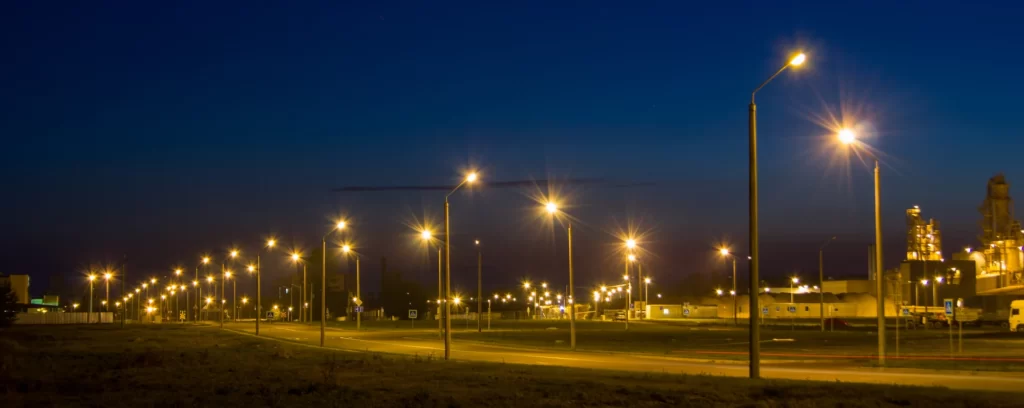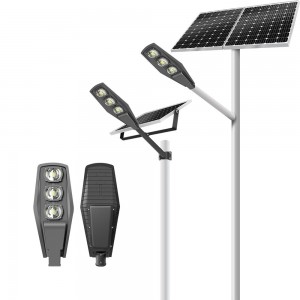Importance of Professional Parameters and Lighting Design
A perfect road lighting design with precise illuminance, brightness, and uniformity can maximally enhance the performance of solar street lights, since the solar street light is already a green power source, adding a professional lighting design can improve the performance and save more energy. It's the best of both worlds.
As solar technology advances, solar street light poles and lighting design solutions are increasingly applied on highways, urban roads, village streets, and community sites. But project planners and buyers often ask: “Can solar street lights meet road lighting standards for brightness and safety?”
The answer is yes — provided that the system is designed with the correct illuminance (lux), luminous flux (lumens), and distribution uniformity (U). Let’s analyze the science and provide data-driven recommendations for different applications.
Technical Parameters for Road Lighting
Luminous Flux (lm):
The total light output of an LED fixture. High-quality outdoor LED light fixtures or industrial light fixtures LED from BOSUN achieve ≥160 lm/W efficiency.
Example: 100W LED lamp fixture → 16,000 lumens.
Illuminance (lux):
The light intensity on a surface (lumens per m²). Standards specify minimum lux levels for each road type.
Uniformity (U = Emin / Eavg):
A measure of how evenly light is distributed. Standards require ≥0.25–0.40 depending on road category.
Color Rendering Index (CRI):
≥70 is required to ensure natural visibility of objects, pedestrians, and vehicles.
Road Lighting Standards (Data Reference: CIE, IESNA, CJJ 45-2015)
| Road Type / Site | Average Illuminance (Lux) | Minimum Uniformity (U) | Typical Pole Height | Recommended LED Power (W) | Approx. Lumens | Suggested Solar Panel & Battery |
|---|---|---|---|---|---|---|
| Highways / Arterial Roads | 15–25 lux | ≥0.40 | 9–12m | 120–150W | 18,000–24,000 lm | 1 × 400W solar panel, 60–80Ah LiFePO₄ |
| Urban Secondary Roads | 10–15 lux | ≥0.35 | 7–9m | 80–100W | 12,000–16,000 lm | 300–400W panel, 40–60Ah LiFePO₄ |
| Village / Township Roads | 5–8 lux | ≥0.30 | 6–7m | 40–60W | 6,000–9,000 lm | 200W panel, 20–40Ah LiFePO₄ |
| Parks, Campuses, Communities | 3–6 lux | ≥0.25 | 4–6m | 20–40W | 3,000–6,000 lm | 150–200W panel, 15–30Ah LiFePO₄ |
Lux levels refer to the average road surface illuminance, calculated according to spacing, mounting height, and optics.
Why Distribution Uniformity Matters
Even if a light fixture is bright, uneven distribution creates glare, dark patches, and unsafe zones.
BOSUN’s LED lamp fixture design ensures:
Batwing light distribution (Type II, III, V) tailored for different road widths.
Uniformity U ≥ 0.35–0.40, meeting international standards.
High luminous efficacy (≥160 lm/W), ensuring maximum brightness with minimal energy use.
Example: A solar street light with battery using a 100W LED lamp (≈16,000 lm) with proper optics can light a 7m-wide urban road at 12 lux average, uniformity 0.37 — fully compliant with urban secondary road standards.
Recommended Parameters for BOSUN Solar Street Lights
Highway Projects
120–150W LED fixture (~20,000 lm)
400 watt solar panel + 60–80Ah LiFePO₄ battery
10–12m pole
Urban Road Projects
80–100W LED fixture (~14,000 lm)
300–400W solar panel + 40–60Ah LiFePO₄ battery
7–9m pole
Village / Township Lighting
40–60W LED fixture (~8,000 lm)
200 watt solar panel + 20–40Ah LiFePO₄ battery
6–7m pole
Parks / Campuses
20–40W LED fixture (~5,000 lm)
150–200W solar panel + 15–30Ah LiFePO₄ battery
4–6m pole
How to Design the Perfect Solar Street Lighting Solution
Designing a reliable solar street light pole involves more than just choosing a panel and fixture. It’s about creating a system that meets lighting standards while optimizing energy usage. A perfect design maximizes performance, saves costs, and extends lifespan.
Understand the Project Requirements
Road Type: Highway, secondary road, village, or community space.
Lighting Objective: Safety, visibility, or decorative/landscape illumination.
Operating Conditions: Climate, sunshine hours, wind load, dust, humidity.
Example: A highway needs ≥20 lux with high uniformity, while a village path may only need 5–8 lux.
Select the Right LED Fixture
High Luminous Efficiency: ≥160 lm/W (BOSUN’s outdoor LED light fixtures).
Optics: Secondary lenses (Type II, III, V) to match road width and pole spacing.
Durability: IP66+, IK08, and surge protection ≥6kV.
Lumen Package: Match road type (6,000–24,000 lm).
Solar street lights can meet and exceed road/site standards for brightness and safety. By correctly matching lumens, illuminance, and distribution uniformity to the application, a solar street light with pole and battery becomes a reliable, sustainable solution.
A 400 watt solar panel system is ideal for highways, while a 200 watt solar panel setup perfectly suits village or township roads. Paired with BOSUN’s outdoor LED light fixtures, industrial light fixtures LED, and long-life LiFePO₄ batteries, these systems ensure stable, uniform, and cost-effective lighting for more than a decade.
BOSUN Lighting’s engineering philosophy is clear: safety first, standards-compliant, and performance guaranteed — making our solar street lights the trusted choice for highways, urban infrastructure, and rural revitalization projects alike.
Post time: Aug-21-2025







